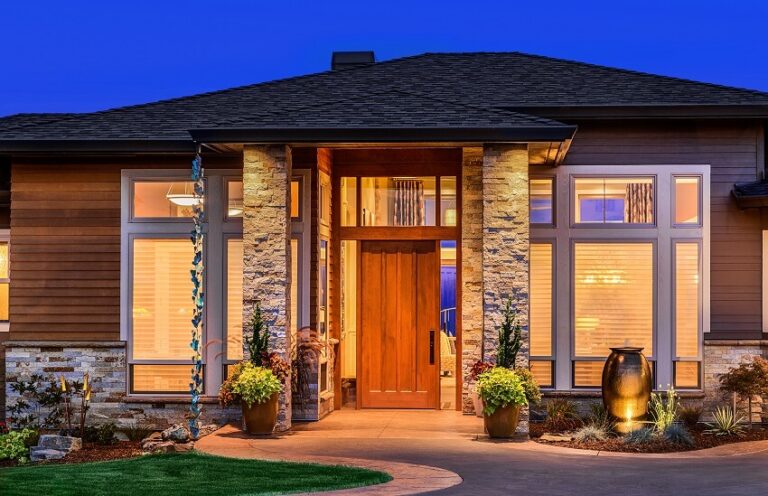Gas vs Wood Fire Pit
Here’s our gas vs wood fire pit guide including pros and cons, how they work, differences, cost and how much propane a gas fire pit uses.

Adding a fire pit to your outdoor space is a fun and exciting prospect.. The first choice you need to make is whether to choose a gas or wood fire pit. Learn how they work, familiarize yourself with the benefits and drawbacks of each style, and get the answers to common questions before making your decision.
How Does a Propane vs Wood Fire Pit Work
Wood fire pits consist of a basin, bowl, or trough where logs are laid and ignited. They are most often made out of steel. Wood fire pits may have trays for ash collection or adjustable ventilation. Some wood fire pits can also be used to grill food.
Propane fire pits have a hose that connects to a tank or canister of gas. The gas flows through the hose and pipes before exiting through strategically drilled holes.
When the gas is turned on and a source of ignition (like a lighter or spark) is introduced to the flow of gas, it ignites. The steady flow of fuel maintains the flame.
Pros and Cons of Propane Fire Pits

Safe to Use – They are safe to use, with an adjustable valve to cut off the fuel source in the event of an emergency. With propane, there is no ash to be cleaned up. Propane fire pits do not emit sparks. Make sure you always use the right types of rocks for a fire pit in order for it to remain safe for all users.
Low Maintenance – While purchasing a propane gas fire pit may be slightly more expensive than a wood fire pit, they more than make up for it in ease of maintenance. While gas fire pits need to be monitored while in use, they do not require adjustment other than replacing the propane tank.
Easy to Start – Starting a gas fire pit is as easy as turning a switch and providing a source of ignition. Once you are done enjoying your propane fire pit, you can simply turn it off without fear of reignition.
Easy to Fuel – Propane is widely available and relatively inexpensive, making these fire pits easy to run and maintain.
They Emit Carbon Monoxide – Propane fire pits do generate carbon monoxide, so they can only be used in areas with adequate ventilation.
Pros and Cons of Wood Fire Pits

Wood is Cheaper than Gas – Wood is generally less expensive than propane gas. This is especially true if you have wood on your property that can be used to fuel the fire pit.
Just Need Wood – To fuel a wood fire pit, you will need a supply of seasoned wood. Your wood pile should be covered from the elements and stacked away from your home’s exterior walls.
Less Energy Efficient Than Propane – A wood fire pit provides a safe and contained space in which to build and maintain a fire. However, it emits more emissions into the atmosphere than propane.
Higher Maintenance than Propane – Ashes are collected in the base of the fire pit and must be cooled before they can be appropriately discarded.
Emits Carbon Monoxide – Due to the creation of carbon monoxide during the wood-burning process, wood fire pits are not safe for use inside a building or under a roof of any kind.
Gas vs Wood Fire Pit Cost
The cost of a gas vs wood fire pit can vary significantly based on a few important factors.
Wood or propane-burning fire pits do not have associated installation costs unless you pay to have them delivered or assembled. If you have a gas fire pit and it needs to be connected to the main gas line, this will be a significant additional cost.
Plan to spend between $5,000 and $10,000 installing a custom gas fireplace connected to the main gas line.
Small, basic wood fire pits can be found for $150 and under. Larger, more decorative wood fire pits tend to cost between $150 and $600. Designer and custom wood fire pits are spectacular statement pieces but can cost many thousands of dollars.
To use propane-burning fire pits, you will need to purchase a canister of propane. The cost of the canister varies by location, usually between $30 and $60.
After this initial purchase, you can swap empty canisters for full ones and pay only for the price of fuel. The price of propane fluctuates, but it generally costs $20 or less for a fresh canister.
A basic propane fire pit should cost $150 or less, while higher-end models may cost up to $1,500. Some units come with lava rocks or glass included, but you may need to purchase these separately.
Are Propane Fire Tables Safe?

Place your propane fire table on a level surface. To ensure adequate ventilation, never use a propane fire table indoors (even in the garage) or under a roof, canopy, or awning.
Ensure the area above the propane fire table is clear of any foliage or hanging branches. Keep the shutoff valve clear of obstructions for quick and easy access in the event of a conflagration.
Do Propane Fire Pits Give Off Heat?
Propane fire pits do give off heat, but how much heat they give off depends on the fire pit design and size. The heat you feel from a propane fire pit depends on the arrangement of your furniture and the placement of your propane fire pit.
Choosing an area that is sheltered from the wind, placing furniture close to the flames, and increasing the flame height will all increase the amount of heat you get from a propane fire pit.
Propane fire pits can generate a similar amount of BTUs as wood fire pits, so the two products should be similar in heat generation. However, many people experience wood fires as warmer than propane fires, perhaps because of the larger flames.
How Much Propane Does a Gas Fire Pit Use?
The amount of propane used by a gas fire pit depends on a few different variables. Larger gas fire pits will use more propane than smaller units.
The height of the flame also affects how much propane is consumed during each hour of use. Even the weather can affect propane usage, with more fuel required to sustain the fire pit on windy days than calm ones.
Pay attention to how many British Thermal Units, or BTUs, the device generates. Fire pits with higher average BTUs will generate more heat and use more propane than lower-powered devices.
A standard 20-pound bottle of propane contains enough fuel to produce 420,679 BTU. A gas fire pit that produces 50,000 BTU per hour can run for just over eight hours on a single tank of propane.
A 40,000 BTU per hour fire pit will last longer, almost 11 hours, but will not generate as much heat. For a 60,000 BTU per hour gas fire pit, plan to replace the propane tank every seven hours or so.
Can You Burn Wood in a Gas Fire Pit?
No, you cannot burn wood in a gas fire pit. Burning wood in a gas fire pit is unsafe and likely to damage the unit. The debris generated by burning wood can enter the delicate parts of the gas fire pit. Ash and coals from a wood-burning fire could damage your gas fire pit, rendering it unusable.
Combination Gas and Wood Burning Fire Pit
If you already have a wood-burning fire pit, there are kits you can use to convert it into a gas fire pit. However, once the conversion is complete, the fire pit can no longer be used to burn wood.
Unfortunately, the delicate mechanisms for gas fire pits are incompatible with burning wood, so it isn’t possible to burn wood and gas in the same fire pit.
For more related content visit our fire pit dimensions guide here.







